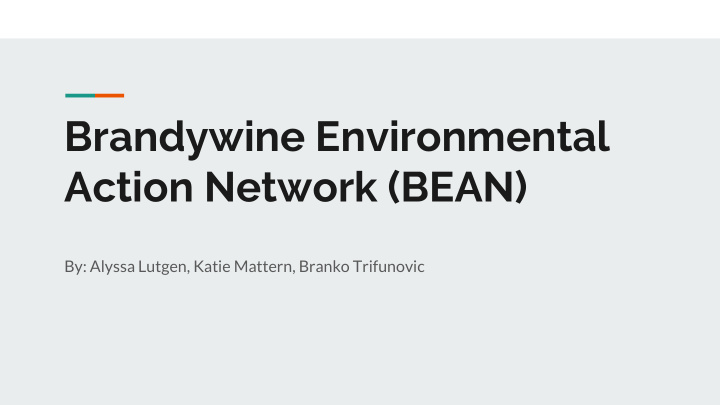



Brandywine Environmental Action Network (BEAN) By: Alyssa Lutgen, Katie Mattern, Branko Trifunovic
Colonial Background/History Unami Lenape used the area for ● fishing, hunting, and agriculture Disease and warfare reduced their ● numbers and allowed Sweden to colonize in 1636 Swedes soon gave way to the Dutch ● (1654) and English (1681) William Penn’s religious tolerance ● attracted many to the region In 1724 Lenape lodged formal ● complaint that dams hurt their fishing
Post-Colonial Background/History The Brandywine’s strong waters ● allowed it to become an industrial mill center Industrial output grew during the ● Civil War and both world wars Horsecar line, cars, highways ● contributed to suburbanization of watershed Corporate friendly tax policies still ● draw people to Wilmington
Brandywine Conservancy Mission Statement: “The Brandywine Conservancy protects and conserves the land, water, natural and cultural resources of the Brandywine-Christina watershed.” Provides conservation and land planning assistance. ● Riparian buffer plantings, stormwater management designs, ● conservation easements. Engages the community with projects and partners with municipal ● officials, nonprofits, and other agencies. Brandywine Creek Greenway ●
Brandywine Creek TMDL: Clean Water Act requires assessment of water bodies every 2 years ● Listed on 303(b) list as impaired water body - requires TMDL ● 2006 - TMDL for sediment, bacteria, nutrients ●
Mission Statement BEAN’s mission is to increase the safety of recreational activities in the Brandywine Creek by improving in-stream habitat quality by 2035.
Problem 1: Nutrients Sources: Wastewater treatment plants ● Urban stormwater runoff ● Agricultural Runoff- 45% land use ● Solution Stream crossing with exclusion fencing (NRCS Alabama). Agricultural BMPs ● Nutrient management plans for applicable farms ●
Problem 2: Bacteria Sources: Sewage, agriculture, wildlife ● Solution Source-based ● Human, Livestock, Dogs, ○ Wildlife Reduce stormflow ●
Problem 3: Sediment Sources: Urban and agricultural ● Solution Permeable pavement ● Rain gardens ● Riparian buffers ●
BEAN goals Permeable pavement and rain gardens in urban areas - reduce ● sediment Riparian buffer zones in agricultural areas - reduce sediment ● Install agricultural BMPs ● Ensure farmers obtain and implement a nutrient management plan ● Reduce stormflow and use adaptive source-based strategies to ● decrease bacteria
Recommend
More recommend